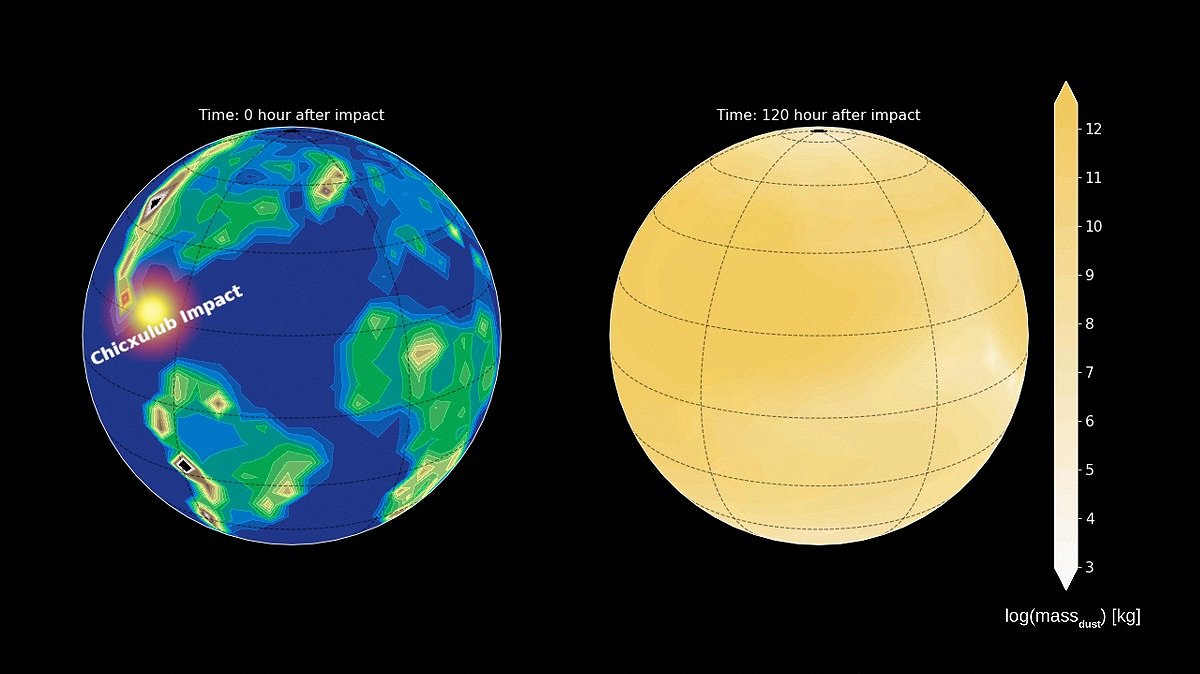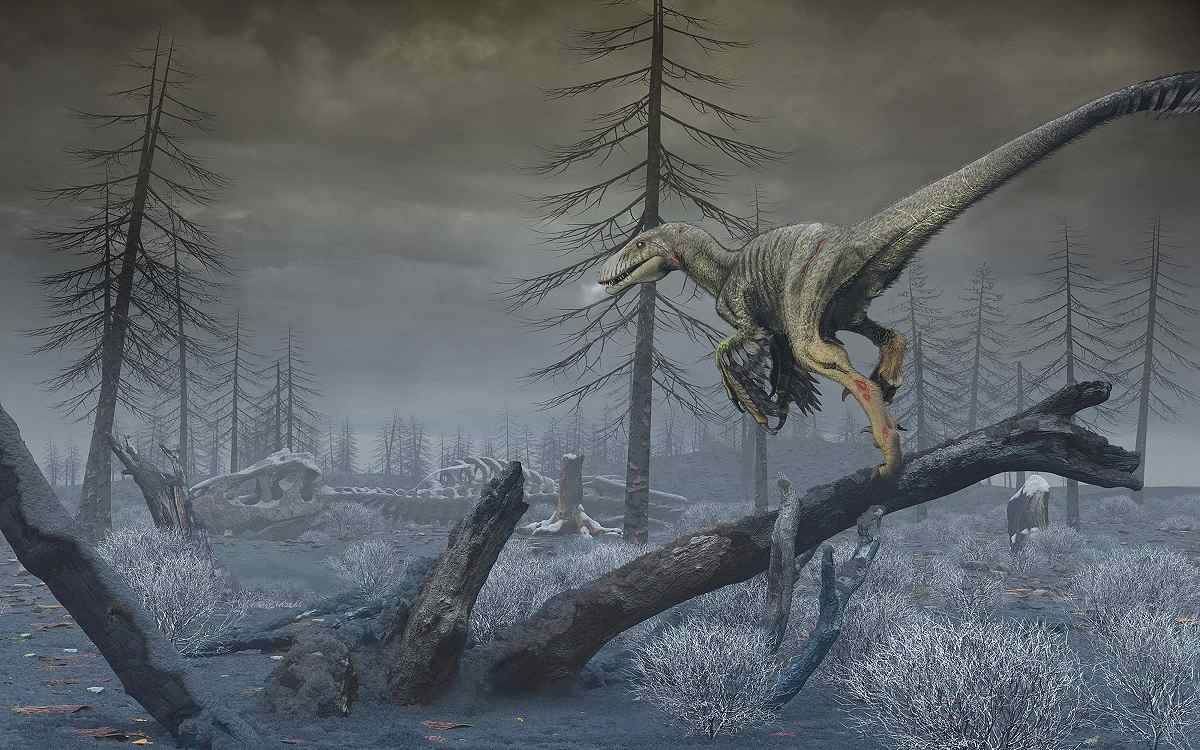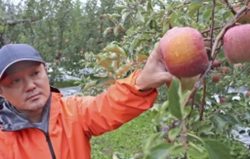
This undated illustration depicts paleoclimate model simulations that show the rapid dust transport across Earth, indicating that the world was encircled by the silicate dust ejecta within a few days following the impact of an asteroid off Mexico’s coast 66 million years ago.
13:19 JST, November 11, 2023
WASHINGTON (Reuters) — It was, to put it mildly, a bad day on Earth when an asteroid smacked Mexico’s Yucatan Peninsula 66 million years ago, causing a global calamity that erased three-quarters of the world’s species and ended the age of dinosaurs.
The immediate effects included wildfires, quakes, a massive shockwave in the air and huge waves in the seas. But the coup de grace for many species may have been the climate catastrophe that unfolded in the following years as the skies were darkened by clouds of debris and temperatures plunged.
Researchers on Oct. 30 revealed the potent role that dust from pulverized rock ejected into the atmosphere from the impact site may have played in driving extinctions, choking the atmosphere and blocking plants from harnessing sunlight for life-sustaining energy in a process called photosynthesis.
The total amount of dust, they calculated, was about 2,000 gigatons — exceeding 11 times the weight of Mt. Everest.
The researchers ran paleoclimate simulations based on sediment unearthed at a North Dakota paleontological site called Tanis that preserved evidence of the post-impact conditions, including the prodigious dust fallout.
The simulations showed this fine-grained dust could have blocked photosynthesis for up to two years by rendering the atmosphere opaque to sunlight and remained in the atmosphere for 15 years, said planetary scientist Cem Berk Senel of the Royal Observatory of Belgium and Vrije Universiteit Brussel, lead author of the study published in the journal Nature Geoscience.
While prior research highlighted two other factors — sulfur released after the impact and soot from the wildfires — this study indicated dust played a larger role than previously known.
The dust — silicate particles measuring about 0.8-8.0 micrometers — that formed a global cloud layer were spawned from the granite and gneiss rock pulverized in the violent impact that gouged the Yucatan’s Chicxulub (pronounced CHIK-shu-loob) crater, 180 kilometers wide and 20 kilometers deep.
In the aftermath, Earth experienced a drop in surface temperatures of about 15 C.
“It was cold and dark for years,” Vrije Universiteit Brussel planetary scientist and study coauthor Philippe Claeys said.
Earth descended into an “impact winter,” with global temperatures plummeting and primary productivity — the process land and aquatic plants and other organisms use to make food from inorganic sources — collapsing, causing a chain reaction of extinctions. As plants died, herbivores starved. Carnivores were left without prey and perished. In marine realms, the demise of tiny phytoplankton caused food webs to crash.
“While the sulfur stayed about eight to nine years, soot and silicate dust resided in the atmosphere for about 15 years after the impact. The complete recovery from the impact winter took even longer, with pre-impact temperature conditions returning only after about 20 years,” Royal Observatory of Belgium planetary scientist and study coauthor Ozgur Karatekin said.
The asteroid, estimated at 10-15 kilometers wide, brought a cataclysmic end to the Cretaceous Period.
The dinosaurs, aside from their bird descendants, were lost, as were the marine reptiles that dominated the seas and many other groups. The big beneficiary were the mammals, who until then were bit players in the drama of life but were given the opportunity to become the main characters.
“Biotic groups that were not adapted to survive dark, cold and food-deprived conditions for almost two years would have experienced massive extinctions,” Karatekin said. “Fauna and flora that could enter a dormant phase — for example, through seeds, cysts or hibernation in burrows — and were able to adapt to a generalistic lifestyle — not dependent on one particular food source — generally survived better, like small mammals.”
Without this disaster, dinosaurs might still dominate today.
“Dinos dominated Earth and were doing just fine when the meteorite hit,” Claeys said. “Without the impact, my guess is that mammals — including us — had little chance to become the dominant organisms on this planet.”

This undated artist’s reconstruction depicts North Dakota in the first months following the impact of an asteroid off Mexico’s coast 66 million years ago, showing a dark, dusty and cold world in which the last non-avian dinosaurs were on the edge of extinction.
"Science & Nature" POPULAR ARTICLE
-

Genome Study Reveals Milestone in History of Cat Domestication
-

Big Leap in Quest to Get to Bottom of Climate Ice Mystery
-

Security Camera Footage Vulnerable to Outside Access; Investigation Finds 3,000 Pieces Exposed Online
-

Japan Set to Participate in EU’s R&D Framework, Aims to Boost Cooperation in Tech, Energy
-

Paws on Parade: Nairobi’s Dogs Dazzle at ‘Pawchella’
JN ACCESS RANKING
-

Tokyo Economic Security Forum to Hold Inaugural Meeting Amid Tense Global Environment
-

Keidanren Chairman Yoshinobu Tsutsui Visits Kashiwazaki-Kariwa Nuclear Power Plant; Inspects New Emergency Safety System
-

Imports of Rare Earths from China Facing Delays, May Be Caused by Deterioration of Japan-China Relations
-

University of Tokyo Professor Discusses Japanese Economic Security in Interview Ahead of Forum
-

Japan Pulls out of Vietnam Nuclear Project, Complicating Hanoi’s Power Plans






















